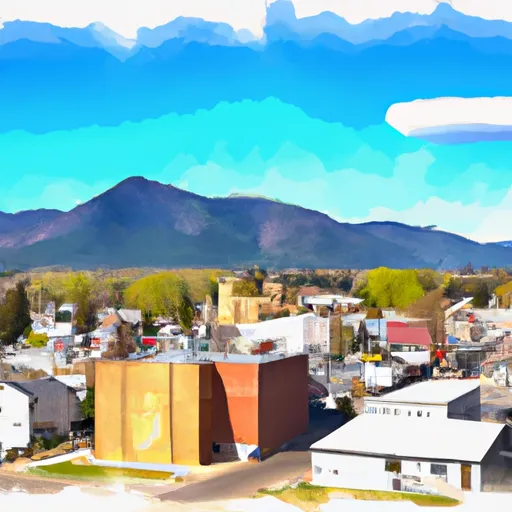-
 Snoflo Premium
Snoflo Premium
Get unlimited access to all our content
With no Ad interruptions! - Start Your Free Trial Login with existing account
Montpelier
Eden Index
Climate
6.7
•
Recreation
1.4
•
Community
2.2
•
Safeguard
3.7/10

Montpelier, Idaho is a charming small town located in Bear Lake County. With a population of around 2,500, Montpelier offers a peaceful and scenic environment. The town experiences a typical continental climate, characterized by warm summers and cold winters. Average summer temperatures range from the mid-70s to low 80s Fahrenheit, while winter temperatures can drop to the low teens, with occasional dips into sub-zero territory.
Montpelier is nestled near the Bear River, providing a picturesque backdrop and a source of hydrology constituents. The Bear River is a valuable water resource that contributes to the region's agricultural activities and supports diverse wildlife. Fishing and boating enthusiasts can enjoy the river and nearby Bear Lake, famous for its turquoise-blue waters.
The area surrounding Montpelier offers numerous outdoor recreation opportunities. Water sports such as swimming, jet skiing, and paddleboarding are popular at Bear Lake. Outdoor enthusiasts can explore the nearby mountains, which provide ample opportunities for hiking, camping, and wildlife viewing. In the winter, visitors can enjoy snowmobiling, cross-country skiing, and ice fishing. Montpelier is a haven for nature lovers seeking to explore and appreciate the beauty of Idaho's landscapes.
What is the Eden Index?
The Snoflo Eden Index serves as a comprehensive rating system for regions, evaluating their desirability through a holistic assessment of climate health, outdoor recreation opportunities, and natural disaster risk, acknowledging the profound impact of these factors on livability and well-being.
Climate Health Indicator (CHI): 6.7
Montpelier receives approximately
362mm of rain per year,
with humidity levels near 68%
and air temperatures averaging around
6°C.
Montpelier has a plant hardyness factor of
5, meaning
plants and agriculture in this region thrive during a short period during spring and early summer. Most
plants will die off during the colder winter months.
By considering the ideal temperature range, reliable water supplies, clean air, and stable seasonal rain or snowpacks, the Climate Health Indicator (CHI) underscores the significance of a healthy climate as the foundation for quality living.
A healthy climate is paramount for ensuring a high quality of life and livability in a region, fostering both physical well-being and environmental harmony. This can be characterized by ideal temperatures, reliable access to water supplies, clean air, and consistent seasonal rain or snowpacks.
Weather Forecast
Streamflow Conditions
Lower Bear
Area Rivers
Lower Bear
Snowpack Depths
Lower Bear
Reservoir Storage Capacity
Lower Bear
Groundwater Levels
Recreational Opportunity Index (ROI): 1.4
The Recreational Opportunity Index (ROI) recognizes the value of outdoor recreational options, such as parks, hiking trails, camping sites, and fishing spots, while acknowledging that climate plays a pivotal role in ensuring the comfort and consistency of these experiences.
Access to outdoor recreational opportunities, encompassing activities such as parks, hiking, camping, and fishing, is crucial for overall well-being, and the climate plays a pivotal role in enabling and enhancing these experiences, ensuring that individuals can engage in nature-based activities comfortably and consistently.
Camping Areas
| Campground | Campsites | Reservations | Toilets | Showers | Elevation |
|---|---|---|---|---|---|
| Mill Canyon | 10 | 6,751 ft | |||
| Summit View | 18 | 7,217 ft | |||
| Bear Lake State Park | None | 5,949 ft | |||
| Diamond Creek | 8 | 6,909 ft | |||
| Montpelier Canyon | 13 | 6,241 ft |
Nearby Ski Areas
Catastrophe Safeguard Index (CSI):
The Catastrophe Safeguard Index (CSI) recognizes that natural disaster risk, encompassing floods, fires, hurricanes, and tornadoes, can drastically affect safety and the overall appeal of an area.
The level of natural disaster risk in a region significantly affects safety and the overall livability, with climate change amplifying these risks by potentially increasing the frequency and intensity of events like floods, fires, hurricanes, and tornadoes, thereby posing substantial challenges to community resilience and well-being.
Community Resilience Indicator (CRI): 2.2
The Community Resilience Indicator (CRI) recognizes that education, healthcare, and socioeconomics are crucial to the well-being of a region. The CRI acknowledges the profound impact of these elements on residents' overall quality of life. By evaluating educational resources, healthcare accessibility, and economic inclusivity, the index captures the essential aspects that contribute to a thriving community, fostering resident satisfaction, equity, and social cohesion.

